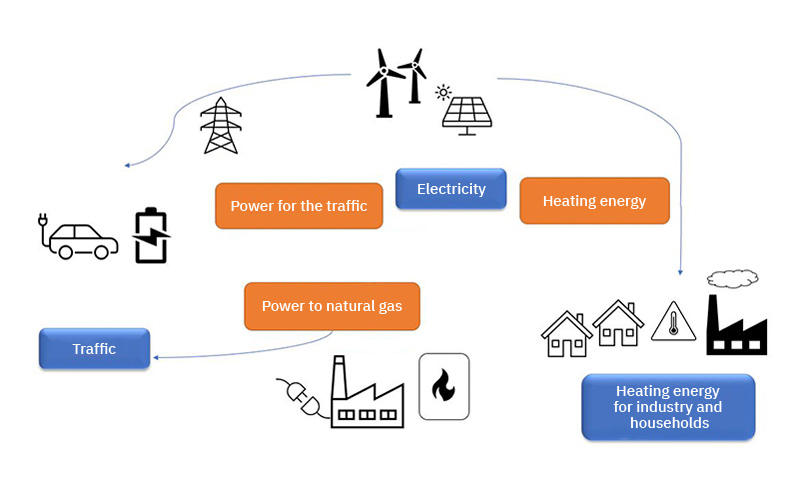Fimpec – experts of the energy transition

The energy transition is a hot topic and a reality. The desire to reduce emissions and mitigate climate change has sparked a transition that is fundamentally changing the entire energy industry and how it operates. Fimpec is closely involved in this transition and offers its customers innovative renewable energy solutions to help them respond to the challenges brought by the energy transition.
The energy sector is currently undergoing a major change. Emission targets are forcing energy markets to forgo fossil fuels as a means of mitigating climate change. This energy transition is fundamentally changing energy production and consumption systems. Fimpec actively supports companies struggling with the transition.
The issue involves more than just switching from combustion technology to clean technology. In the current energy transition, it is not just production, but also the energy networks, delivery and emergency supply that are in the throes of change. The future energy system will not only be cleaner, it will also be more complex, with the different sectors closely linked to one another. Business and revenue models will also change when regular consumers are joined by ‘prosumers’, i.e. individuals who both produce and consume. The situation is challenging for operators in the energy industry, but the means for implementing the change already exist and are constantly evolving.
“At Fimpec we have taken this change into account well in advance, both in our operations and in developing our competencies. We are involved in many pioneering projects and can offer our customers expertise and consulting, from concept-level engineering to actual implementation,” explains engineer Andreas Lund (M.Sc.Eng.), who works as a consultant at Fimpec and whose areas of expertise are renewable energy and related innovative solutions, such as geothermal energy and power-to-x technologies.
Electrification is key in the energy transition
Lund cites electrification, meaning transitioning from fossil-based energy to renewably generated electricity and utilising it either directly or indirectly, as a decisive factor. Direct electrification can already be seen in traffic and in heat production, but it is also the future for other sectors. Thanks to its extensive experience in engineering and project management tasks in the energy sector, Fimpec is a competent and innovative partner in this area.
“The electrification of heat production calls for new technologies. Combustion-based heating methods are giving way, for example, to electric boilers, heat pumps and geothermal energy. One example of this is that when it comes to large heat pumps, the sizes are already moving from real-estate scale to megawatt scale. Geothermal energy, for its part, offers massive potential worldwide. In that area, new solutions are needed, such as deep-heat wells, which differ from traditional geothermal wells in their technology, well depth and scale. A good example of this is the energy company Helen’s geothermal heating plant in Ruskeasuo. Another heat pump trend is seawater heat pumps,” says Lund.
Both heat pumps and deep-well pumps are systems in which Fimpec has wide-ranging expertise. Fimpec’s experts have been involved in many projects related to these systems.
Green hydrogen offers a means of indirect electrification
The significance and importance of hydrogen in the energy transition has been highlighted, and there are high hopes for it. In Lund’s opinion, this is understandable, as in many sectors direct electrification is difficult. Among the sectors that face electrification challenges are the chemicals industry, steel production and heavy and long-distance transport.
“In these sectors, fuels will be needed in future, too, and hydrogen produced with renewable energy, i.e. ‘green hydrogen’, will enable emission reductions also where direct electrification is not possible,” Lund explains. “Hydrogen and its downstream products can replace fuels and natural gas. They also offer the possibility of storing surplus electricity, for instance, as synthetic fuel that can be used to balance variations in electricity and heat consumption and production.”
Fimpec’s expertise also extends to the design and implementation of various hydrogen-economy solutions, such as the conceptualisation and engineering of hydrogen production plants.
“Together with the customer, we can determine what kind of electrolysis plant they want and how it should be built. Our special expertise also includes innovative solutions, comparing electrolysers and methanation integration. We are on the crest of a wave in hydrogen economy development and involved in groundbreaking projects, such as P2X Solutions’ green hydrogen production plant in Harjavalta,” says Lund.
Affordable electricity and solutions for electricity surplus and deficit
An essential condition for implementing the energy transition and the electrification it requires is affordable renewable electricity. It is needed in both direct and indirect electrification and is also the essence of the entire hydrogen economy.
“Renewable electricity production is increasing rapidly, which is helping to tackle the challenge. However, it does not eliminate the problem of periodic imbalances in electricity production and consumption. The challenge is variations: there are variations in wind and solar energy production, and electricity consumption can likewise vary significantly. Particularly in Finland, heating focusses on cold periods, and in terms of traffic, electric-car charging causes consumption spikes within a single 24-hour period,” says Lund.
However, Lund says that new solutions, such as heat storages and the use of hydrogen, have emerged to solve the problem, and these are areas in which the Fimpec team can help.


